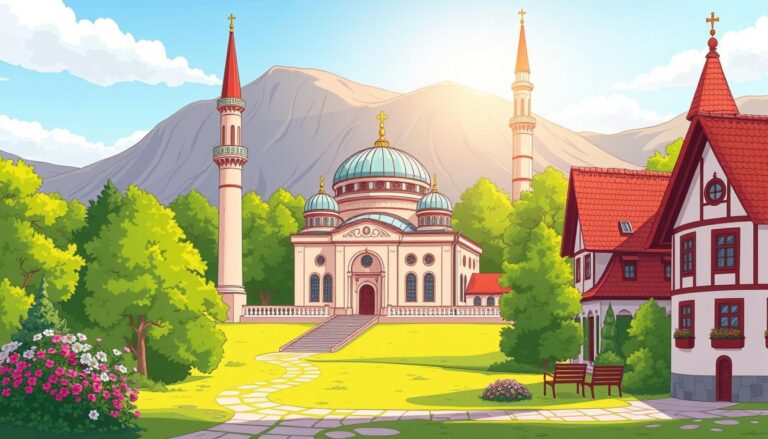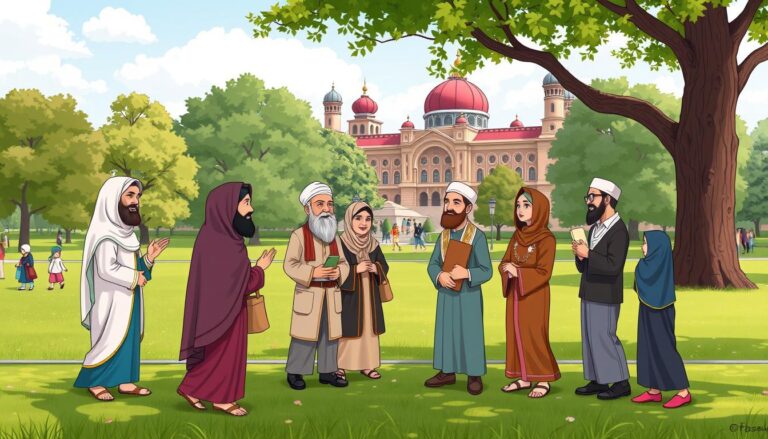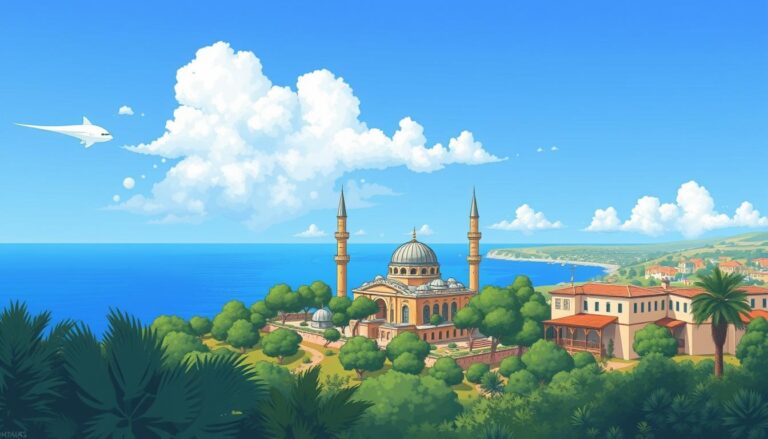Islam in Denmark
According to a 2020 analysis, there are an estimated 256,000 Muslims in Denmark, comprising a significant 4.4% of the country’s population. This sizable Muslim community has profoundly shaped Denmark’s social and religious landscape over the past several decades. The majority of Danish Muslims follow the Sunni tradition, with a notable Shia minority and a presence of Ahmadiyya community members as well.
Muslims have immigrated to Denmark in successive waves since the late 1960s, primarily as workers and later as refugees fleeing conflicts in their home countries. This influx has transformed Denmark’s historically homogeneous society, leading to both integration successes and societal tensions. While Denmark is renowned for its religious tolerance, the increasing diversity has also given rise to debates around issues such as religious symbols, cultural practices, and immigration policies.
Key Takeaways
- Denmark has a significant Muslim population, comprising around 4.4% of the total population.
- The Muslim community in Denmark is diverse, with Sunni Muslims as the majority, a notable Shia minority, and the presence of Ahmadiyya members.
- Muslim immigration to Denmark has occurred in waves since the late 1960s, with both economic and refugee-related factors driving this demographic shift.
- The growth of Islamic institutions, including mosques and Islamic schools, reflects the increasing integration of Muslims in Danish society.
- Debates around religious tolerance, cultural practices, and immigration policies have emerged as Denmark grapples with its evolving religious landscape.
Demographics of Islam in Denmark
The Muslim population in Denmark has been steadily growing over the past few decades. While the exact number is difficult to determine as the government does not collect data on individual religious beliefs, estimates suggest the Muslim population has risen from around 30,000 (0.6% of the population) in 1980 to an estimated 256,000 (4.4%) in 2020.
Muslim Population Statistics
The majority of Danish Muslims are of the Sunni denomination, with a significant Shia minority. The community also includes members of the Ahmadiyya sect. The Muslim population statistics in Denmark indicate a continuous growth in the overall Muslim population in the country.
Ethnic and National Origins
Muslims in Denmark have diverse ethnic and national origins, with large populations from Turkey, Pakistan, Morocco, the former Yugoslavia, Iran, Iraq, Somalia, and Syria, among others. This diversity reflects the growth of the Muslim population in Denmark over the years, as the country has welcomed immigrants and refugees from various parts of the world.
“About 270,000 Muslims live in Denmark, making Islam the largest non-Christian religion in the country.”
- The Danish constitution guarantees freedom of religion, and non-Christian religions receive the same tax advantages as the state church.
- There are two grand mosques in Copenhagen and over 100 mosques throughout Denmark.
- The Great Synagogue of Copenhagen was founded in 1833 for the Jewish community which has been practicing their religion in Denmark for over 400 years.
Historical Overview of Islam in Denmark
The history of Islam in Denmark stretches back centuries, marked by encounters between the Scandinavian nation and the Muslim world. While the presence of Muslims in Denmark dates primarily to the 1960s, the country’s interactions with Islamic cultures and faiths extend much further back in time.
During the Middle Ages, Danish military forces participated in the Crusades, battling to take control of Jerusalem from Muslim rule. In the 17th and early 18th centuries, some Danes were taken captive by Muslim pirates, with sources indicating that some of them converted to Islam during their captivity.
Early Encounters and Influence
Denmark’s connections with the Muslim world are further evidenced by the travels of King Frederick V, who visited South Arabia in the 18th century to collect information and artifacts. One of the earliest known Danish converts to Islam was Knud Holmboe, a journalist and writer who detailed his experiences in the Libyan Genocide.
- An 1880 Danish census recorded 8 “Mohammadans” in the country, and censuses continued to be carried out until 1970.
- The presence of Muslims in Denmark dates back to the 1960s when workers from North Africa, Turkey, and Pakistan migrated to the country due to increased demand for labor during the industrial boom.
- Refugees have been arriving in Denmark since the early 1980s from countries like Iran, Lebanon, Turkey, Iraq, Somalia, Afghanistan, and Syria, due to conflicts and civil wars.
“History is a dialogue between the past and the present. The encounters between Denmark and the Muslim world have shaped the nation’s cultural and religious landscape in profound ways.”
The history of Islam in Denmark is a tapestry of cultural exchange, conflict, and the evolving presence of Muslim communities within the Scandinavian nation. As the country continues to grapple with the complexities of integration and identity, this rich history provides important context for understanding the role of Islam in Denmark’s past, present, and future.
Waves of Muslim Immigration
Muslim immigration to Denmark has ebbed and flowed over the decades, shaping the country’s evolving demographics. Large-scale migration began in the 1950s and 1960s, driven by Denmark’s economic expansion and industrialization. Migrants, primarily from Yugoslavia, Turkey, Pakistan, and North Africa, arrived to fill labor shortages. In the 1980s and 1990s, a second wave of Muslim immigrants, mainly refugees and asylum seekers, came from Iran, Iraq, Somalia, and Bosnia. More recently, the ongoing conflict in Syria has led to a significant influx of Syrians seeking asylum in Denmark.
These successive waves of immigration have steadily increased the size and diversity of the Muslim population in Denmark. According to recent estimates, Denmark has around 400,000 Muslims, accounting for approximately 7% of the total population. The changing demographic landscape has sparked political debates and influenced the country’s integration policies.
The rise of the Danish People’s Party, the third-largest in Denmark’s parliament, has been partly fueled by concerns over Muslim immigration and the perceived threat to Danish identity. In response, Denmark has toughened its immigration laws in recent years, making it more challenging for asylum seekers and immigrants to gain legal status.
Despite these challenges, the majority of Danes are described as overwhelmingly moderate and tolerant. However, some radical Islamic organizations, such as Hizb ut-Tahrir, have established a presence in the country, further complicating the integration landscape. Imams like Abdul Wahid Pedersen play a crucial role in navigating these complexities and fostering a more inclusive society.
Legal Status and Recognition
In Denmark, the legal status and recognition of Islam remain an ongoing debate. While the Constitution of Denmark guarantees freedom of religion, the Evangelical Lutheran Church (ELC) enjoys certain privileges, such as state subsidies, that other religious groups do not receive.
As of 2013, 23 different Muslim communities in Denmark have been recognized as “acknowledged religious communities,” granting them certain tax benefits. This recognition process, handled by the Ministry of Ecclesiastical Affairs, requires a congregation to have at least 50 adult members.
Constitutional Provisions and Privileges
Denmark’s constitution provides for the freedom of religion, but the ELC maintains a special status as the country’s national church. Unrecognized religious groups are allowed to practice without public registration, but their members must marry in a civil ceremony in addition to any religious rites. Contributions from members of unrecognized groups are tax-deductible, but these groups do not receive full tax-exempt status.
- The ELC receives 79% of its operating budget from voluntary contributions and 10% from government grants.
- Other religious groups cannot contribute via payroll deduction but can donate voluntarily for a tax deduction.
The legal status and recognition of Islam in Denmark remains a subject of ongoing debate, with tensions surrounding issues like the construction of mosques and the observance of religious practices.
“Denmark is considered one of the most racially homogenous and migrant-averse countries in Europe.”
Islam in Denmark in the 2000s
The Muslim population in Denmark has continued to grow in the 21st century, with the number of asylum seekers and refugees from Muslim-majority countries contributing significantly to this increase. In 2014, the number of Muslims in Denmark rose by 13,000, partly due to a surge in Syrians seeking refuge. These demographic shifts have led to ongoing debates in Danish society about the role of Islam and the integration of Muslim immigrants and their descendants.
The Muslim population in Denmark has seen a steady rise over the past few decades. In 1968, approximately 2,000 Muslims had arrived in Denmark, with many belonging to the Ahmadi community. By 1980, the number had grown to around 29,400. This trend continued, with the Muslim population in Denmark rising to approximately 256,000 by 2020, making up 4.4% of the total population.
The diversity of the Muslim community in Denmark is reflected in the ethnic and national origins of its members. Turks and Syrians make up 18.8% and 11.8% of the Muslim population in Denmark, respectively. This diversity has been a subject of both celebration and debate, as Denmark grapples with the integration of its growing Muslim population.
The presence of Islam in Denmark has also led to the establishment of various religious institutions, such as mosques. In 2017, there were around 170 mosques in Denmark, with only a small fraction being purpose-built. The process of acquiring a mosque often involves forming an association with a Danish name and renting accommodation, leading to the opening and closure of several mosques in different parts of the country.
The debate surrounding Islam in Denmark has been particularly intense, with the 2005 Jyllands-Posten Muhammad cartoons controversy serving as a flashpoint. The publication of the cartoons, which depicted the Prophet Muhammad, led to global protests and was considered Denmark’s worst international relations incident since World War II. This controversy ignited a debate about the limits of freedom of expression, religious tolerance, and the relationship between Muslim minorities and their broader societies in the West.
As Denmark continues to navigate the challenges and opportunities presented by its growing Muslim population, the debates surrounding Islam in the 21st century are likely to persist, shaping the country’s cultural and political landscape in the years to come.
Integration Policies and Debates
Denmark has implemented various policies to address the integration of its growing Muslim population. The 1999 Integration Act aimed to help newly arrived refugees and immigrants integrate on an equal footing with other Danish citizens. However, these policies have faced criticism from some groups for being perceived as discriminatory.
The 2005 Cartoon Controversy
The 2005 publication of cartoons depicting the Prophet Muhammad in a Danish newspaper further strained relations between the Muslim community and the broader Danish society. The controversy sparked outrage and protests, both within Denmark and internationally, and highlighted the tensions surrounding the integration of Islamic culture and traditions in the country.
Debates on Religious Symbols and Practices
Debates have also surrounded the public display of religious symbols, such as the hijab, and the observance of Islamic practices, like ritual animal slaughter. In 2018, the Danish government introduced a ban on full-face coverings in public places, resulting in the first fine being issued to a woman wearing a niqab.
“Nearly a third of Muslims living in Denmark feel that they are looked down upon by the rest of Danish society, according to a survey conducted in 2017.”
The ‘ghetto deal’ targeting 25 largely Muslim-majority areas in Denmark with restrictive policies, including measures such as curfews, increased policing, and a ban on the construction of mosques with minarets, further highlights the ongoing tensions and debates surrounding the integration of Muslims in Denmark.
As Denmark continues to grapple with the challenges of integrating its diverse Muslim population, the debates surrounding integration policies for Muslims in Denmark, the 2005 Danish cartoon controversy, and the debates on Islamic religious symbols and practices remain at the forefront of the national discourse.
Current Challenges and Issues
Muslims in Denmark face a range of pressing challenges and obstacles, from prejudice and discrimination to restrictive immigration policies. These issues have contributed to a growing sense of marginalization within the Muslim community.
Prejudice and Discrimination
Many Muslims in Denmark have reported experiencing prejudice, racism, and discrimination from the broader Danish society. According to a 2017 survey, nearly a third of Muslims living in Denmark feel that they are looked down upon by the rest of Danish society. This sentiment reflects the persistent challenges faced by the Muslim community in Denmark.
Restrictive Immigration Policies
In recent years, the Danish government has implemented increasingly restrictive immigration policies, including making citizenship tests more difficult, reducing benefits for immigrants, and extending the family reunification process. These measures are often viewed as specifically targeting the Muslim community, contributing to a growing sense of exclusion and marginalization.
“The ongoing incidents [of Quran desecrations] are the most serious security policy situation since the Second World War,” said Sweden’s Prime Minister Kristersson.
The rise of right-wing extremist activities and the growing popularity of parties with Islamophobic platforms, such as the Sweden Democrats, have further exacerbated the challenges faced by Muslims in Denmark and the broader Nordic region.
As Denmark grapples with these complex issues, it is crucial that the government and civil society work together to address the systemic prejudice and discrimination faced by the Muslim community, while also ensuring that immigration policies are fair, inclusive, and respectful of human rights.
Islam in Denmark
Islam has become an integral part of Denmark’s social and cultural landscape, with the Muslim community contributing to the country’s diversity. While tensions and challenges remain, the presence of Islam in Denmark has influenced various aspects of society, from architecture and cuisine to debates around national identity and values.
The growth of the Muslim population has led to the establishment of new Islamic institutions, such as mosques and community centers, further solidifying the role of Islam in Danish society. Danish Muslims have also made significant contributions to Danish culture, with their culinary and artistic influences enriching the country’s cultural tapestry.
However, the influence of Islam on Danish culture has also sparked debates and controversies. The politicization of identity and beliefs has pushed some Danish Muslims to the sidelines, leading to challenges in integration and acceptance. This has been exacerbated by the rise of far-right political discourse, which often draws on extreme manifestations of Islam to generate fear and unease.
Despite these challenges, the Danish government has taken steps to recognize the role of Islam in Danish society and promote integration. The National Integration Barometer, produced by the Ministry for Immigration and Integration Ministry, measures progress towards integration goals, addressing the need for a more inclusive and cohesive society.
“Embracing the open practice of minority religions in Denmark could enhance the sense of belonging for Danish Muslims and strengthen the country’s commitment to diversity and pluralism.”
As Denmark continues to navigate the complexities of religious and cultural diversity, the contribution of Muslims to Denmark will undoubtedly remain a topic of ongoing discussion and debate. The challenge lies in striking a balance between preserving national identity and embracing the richness that diversity brings to the country.
Observing Ramadan in Denmark
Ramadan, the holy month of fasting and spiritual reflection in Islam, holds immense significance for Danish Muslims. During this time, families come together for pre-dawn meals and post-sunset Iftar celebrations, reinforcing their community ties and religious devotion.
Significance of Ramadan
The observance of Ramadan in Denmark presents unique challenges due to the country’s northerly location and extended daylight hours. Muslims in Denmark may fast for more than 17 hours a day, as the sun sets late in the evening. In neighboring countries like Norway and Iceland, the fasting period can be even longer, with some congregations taking holiday time to manage the extended daylight. The long fasts can lead to dehydration, fatigue, and withdrawal symptoms, but the body quickly adjusts as the month progresses.
Despite the difficulties, the significance of Ramadan remains strong for Danish Muslims. Eating the pre-dawn meal of suhoor is crucial to provide energy for the day, and the sense of community and spiritual renewal during Iftar celebrations is deeply cherished.
Public Attitudes and Politics
The public observance of Ramadan in Denmark has been a topic of political contention, with some political figures and members of the public expressing discomfort or opposition to the visibility of Islamic practices. This reflects the broader tensions surrounding the integration of Islam and Muslim identities within Danish society.
However, the Danish Muslim community has found ways to navigate these challenges. Organizations like trade unions and transportation companies have reported no issues arising during Ramadan due to fasting, underscoring the adaptability and resilience of Danish Muslims.
“The United Federation of Danish Workers, the largest trade union in Denmark, stated that they had never encountered a single case where fasting during Ramadan had posed a problem.”
Conclusion
As Denmark continues to grapple with the future of Islam in Denmark and the integration of Muslims in Danish society, it stands at a crossroads in terms of its relationship with this growing religious minority. The country’s long history of religious tolerance and its constitutional commitment to freedom of religion provide a solid foundation for a more inclusive and accommodating approach to the public observance of Islamic practices and the celebration of Muslim holidays like Ramadan.
By embracing the rich diversity of its citizens and fostering a greater sense of belonging for Danish Muslims, Denmark can strengthen social cohesion and pave the way for a more harmonious and integrated society. This will require a delicate balance between respecting the cultural and religious identities of its Muslim population while also upholding the values of secularism and free expression that are central to Danish national identity.
As the debate over the importance of religious tolerance and diversity continues to unfold, Denmark stands at a pivotal moment in its evolution as a multicultural society. By navigating these complex issues with wisdom, empathy, and a commitment to the principles of equality and mutual understanding, Denmark can emerge as a model for how Western nations can successfully integrate and celebrate their diverse religious communities.
Source Links
- Islam in Denmark
- Muslims in Denmark – Minority Rights Group
- Islam in Denmark: The Challenge of Diversity
- Religion and identity
- How Denmark is ‘othering’ its Muslim population
- Islam in Denmark – an historical overview
- Islam in Denmark –
- Muslims In Denmark Face A Wave Of Intolerance
- Book examines portrayal of Muslim immigrants in Danish media
- When Liberals Become Conservative: A Danish Political Culture of Islamophobia
- Denmark – United States Department of State
- Denmark – United States Department of State
- Voices of Danish Youth Signal a New Danish Consensus on Islam
- No title found
- Islam in Denmark
- Jyllands-Posten Muhammad cartoons controversy
- Public Debates, Political Opinions, and Freedom of Research / Multiple Secularities
- Denmark: Proposition to ban the hijab in primary schools
- Why Sweden and Denmark React Differently to Quran Desecrations
- Islam as a "floating signifier": Right-wing populism and perceptions of Muslims in Denmark
- How Ramadan is perceived in Denmark today – The Copenhagen Post
- Denmark passes law to ban Quran burnings
- Fasting under the northern light: How Muslims in Scandinavia cope with long Ramadan days
- Danish govt: Minister’s views on fasting Muslims are her own
- Islam and Free Speech in Denmark – Flemming Rose & Mustafa Akyol
- Denmark | Muslims in the EU: Cities Report; Preliminary research report and literature survey







